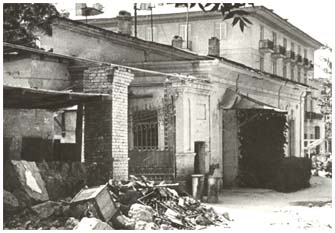The last strongest earthquake taken place in Tashkent April 26, 1966.
This tragically event of the newest history of two-thousand-year city
found the reflection in the memorial "Courage" located on a coast of
ancient channel Anhor. A choice of a place for a monument is not
random. Channel Anhor divides Tashkent on two parts. On the right of
its (western) coast there is an old city, and on east side from Anhor a
so-called new (European) city appeared in second half XIX centuries.
After joining of Tashkent to Russian empire this new city was designed
and built up as the provincial centre of colonial Russian
administration. In this place where there was an epicenter of the
strongest earthquake of 1966, the monument "Courage" was erected.
|
The symbolic of a monument is simple. Huge bronze figures of the woman
with the child on hands and men in expressive jerk before a zigzag
crack in the ground express resistance of inhabitants of Tashkent
against power of terrible underground elements. The crack leads to
broken in two pieces cube from black labrador with the engraved date
"April, 26, 1966" and a dial of stopped clock. Arrows of all city
mechanical clocks in that memorable morning have stopped at 5:23
minutes. And 14 arrows with relieves serve as a background for a
sculpture representing restoration of capital of Uzbekistan.
|
But it is not necessary to think, that tremor force more than 8 points
was the only one. The Tashkent earthquake of 1966 last some months, was
registered about 700 pushes, but energy of them gradually decreased.
Result was full or partial destruction of 36 thousand apartment houses
and public buildings. There were also victims among the townspeople,
but the number of them, fortunately, appeared insignificant.
|








